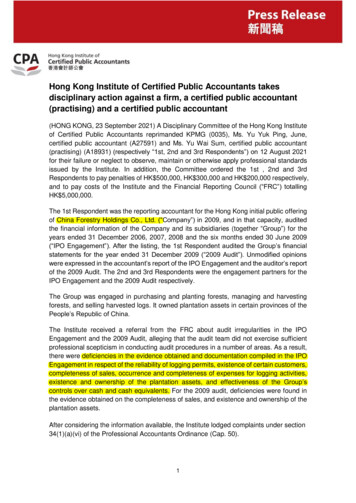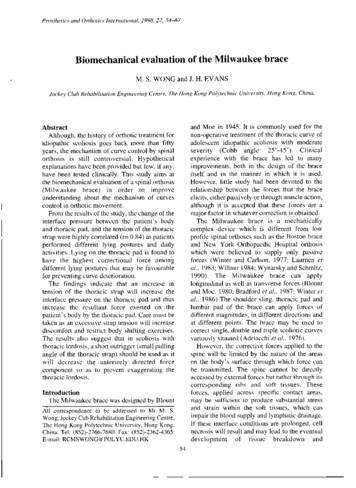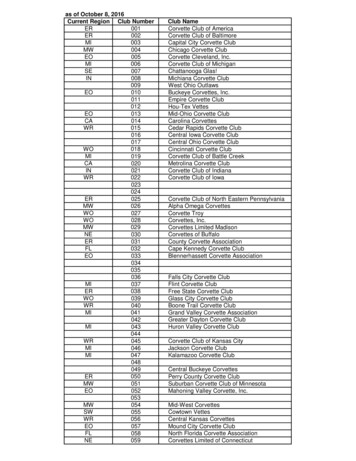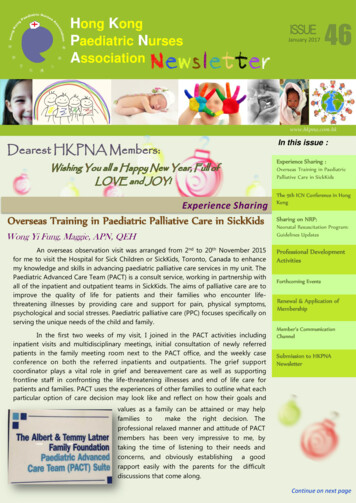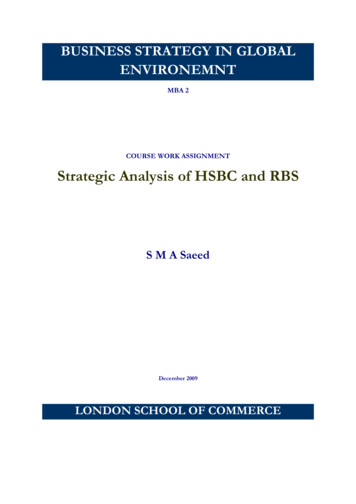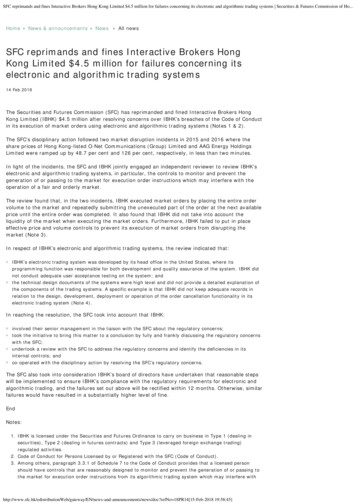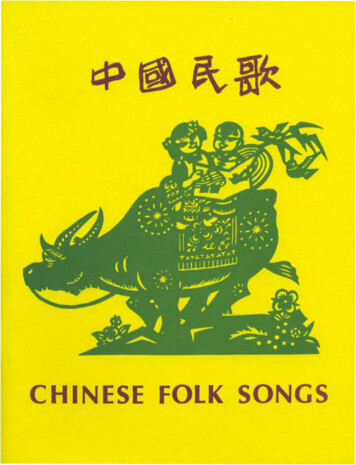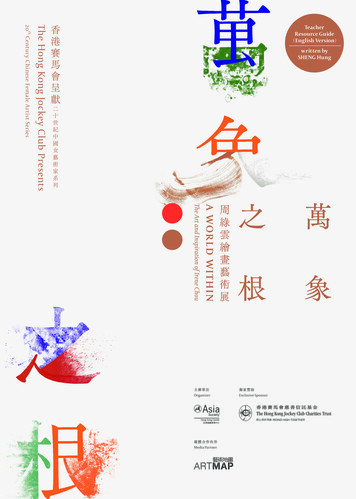
Transcription
香港賽馬會呈獻written bySHENG Hung二十世紀中國女藝術家系列The Hong Kong Jockey Club Presents20th Century Chinese Female Artist SeriesTeacherResource Guide(English edia Partner獨家贊助Exclusive Sponsor
CHAPTER 1ABOUT IRENE CHOUIrene Chou(1924 — 2011)was a prominent distinctive inkpainter and a significant member of the Hong Kong InkPainting Movement. Her shift from the Lingnan Schoolto Ink Painting showed her willingness to try somethingnew. Painting became the most vital element in her life.She said,“I am my art, my paintings are me.” AppreciatingIrene Chou’s art will help us to understand how art canreflect one’s state of mind. Comprehending Chou’s artisticpursuits should also deepen understanding of the essenceof Ink Painting.CHAPTER 2ART OF IRENE CHOU1.1Early Life in Shanghai2.1Study Under Lui Shou Kwan2.2Western Art and other InfluenceChou was born in 1924 in Shanghai and spent her first twentyfour years in that city. Shanghai was the most modern city inChina at that time. Her parents Zhou Lianxuan(1896 — 1982)and Jin Qichao(1901 — 1950)were influenced by the 1919May Fourth Movement. This influence led them to nameChou’s younger sister with her mother’s maiden surnameJin, to emphasize female liberation and sexual equality. Chouwas brought up in an artistic environment. Her parentswere highly educated, her father Zhou was an amateurphotographer and a lover of art and music while her motherwas a calligrapher. Chou’s father often took Chou along tocultural gatherings with elite friends.One of the significant twists in Chou’s artistic endeavoroccurred during the time when she was studying with LuiShou Kwan(1919 — 1975)at the Department of ExtramuralStudies of the Chinese University of Hong Kong. Lui openedthe door of art for her, and she walked through it. She sether own path and became an independent artist. Between1966 and 1968, Chou attended Lui’s classes and acquiredknowledge of traditional Chinese painting, painting theoryand philosophy. Lui encouraged his students to experimentwith different media and to absorb knowledge of art from theWest. He provided a new way of learning Chinese painting. InLui’s teaching, he advocated the term shuimohua(literallywater ink painting, usually abbreviated as “ink painting”)thathighlighted individuality and inner expression. If he had touse one sentence to describe Ink Painting, he would say it is“a kind of painting that uses shuimo(literally water ink)asself-expression”. He encouraged his students to explore visuallanguages and express oneself instead of learning throughimitation. From then on, Chou explored media other thanink, such as acrylic, oil, watercolor and glue; created collage,illustration and print.When Chou was studying on western modern art at theUniversity of Hong Kong, she was attracted by the many artreference books at the American Library of the United StatesInformation Service in Duddell Street and the British CouncilLibrary in the old Gloucester Building. In various interviews,writings, paintings, Chou mentioned Henri Rousseau, HenryMoore, Salvador Dali, Edvard Munch, Wassily Kandisky andothers as influence. All these names explained Chou’s interestsin western modernism that were in favor of exploring the stateof subconscious, psychological intensity and total abstraction.Chou also began to search for her inner self and visuallanguages to express herself and she gradually developed herdistinguished style.In 1941, Chou was admitted to St. John’s University in Shanghai.It was a renowned American run institution with strongwestern influences. She graduated with an economics majorand a sociology minor. Her family and education backgroundhelped to shape her liberal and open-minded attitude. Shewas married to Yang Yanqi(Evan Yang ; 1920 — 1978)in 1947whom she met when she was working briefly as a reporter for. Because of the chaos of the Chinese Civil War, the《Peace Daily》couple first fled to Taiwan, then Hong Kong in 1949. It is notedthat in this period there was no hint Chou had an aspirationto be an artist.1.2Early Encounter with ArtChou first perceived herself as a mother to her children anda wife to her husband, she was not career-minded and startedpainting only by chance. Because Yang was a movie directorand achieved a successful career in the 1950s, they becamea financially secure family. One day when Chou was driving,her friend glanced at Chou’s hands on the steering wheeland commented that Chou’s hands were artistic and that sheshould learn painting. In 1950s, Chou was introduced to thesecond generation of Lingnan School, Chao Shao-an(ZhaoShao’ang ; 1905 — 1998)by wealthy housewife friends. Shepaid serious effort to mimic Chao’s paintings, which were sowell-executed that at times mistaken as Chao’s originals. Thisdemonstrated that Chou attained brilliant skill in using brushand ink, which became the foundation of her later artisticdevelopment. It was obvious that Chou’s art in that periodhad a clear reference to Chao’s use of color, composition andbrushwork. Her belief about art between the late 1950s andearly 1960s was that “art is about imitation”.Chou developed immense interests in meditation andBuddhism in the late 1980s. These profoundly influenced herafter her stroke in 1991. In 1992, she moved to live with her sonin Brisbane, Australia. There, she lived a tranquil and simplelife without television. She started practicing qigong in everyearly morning. She reckoned training her focus throughmeditation would be useful for her to start painting again.By practicing qigong, Chou aimed at achieving a “state ofthoughtlessness”, which she admitted was difficult to attain.Yet, there was a powerful life-force that she still experiencespiritually. There was a saying from Lu Jiuyuan(Lu Xiangshan ;1139 — 1192), a Song dynasty Neo-Confucian intellectual thatChou frequently quoted: “The universe is my heart, my heartis the universe.” She kept exploring the balance of forces of herinner world and the physical universe.003Untitled(Mantis on Ladies Stocking)2006Ink, color and mixed media on paperUntitled(#003)On the calf of the stocking, she painteda “Lingnan School style” mantis in deft strokes. It is anexperimental work that Chou used her stocking in patchesof colors.discussion 1suggested directionWhat is the meaning of painting? How would you define painting?How does the idea that “art is about imitation” differ from “art isabout inner expression”?Do any students in the class attend drawing/painting class? Howdid they learn? Do they learn by imitating teachers’ work, copyingphotographs, free-hand expression or other means?
CHAPTER 2ART OF IRENE CHOUCHAPTER 2ART OF IRENE CHOU2.3Art and ExpressionPainting, as a leisure activity for Chou, evolved to be a processin which she could immerse herself. Later it became hercareer and life. Many of Chou’s paintings serve as monologuesof herself. The deteriorating marital relationship with herhusband, Yang Yanqi, can be seen as a trigger point that ledher to indulge herself in painting as a way through a stressfulsituation. Later on, her paintings at different periods reflecther mental state.Chou’s later works are abstract expression that areconcerned with her state of mind rather than any specificincident. Comparing her piled ink paintings in the 1970s, thevibrant color in her later paintings contemplative emotionstowards life.008Life is a Many Splendored Thing No.52006Ink, color and acrylic on canvas017My Inner World I1976Collection of Hong Kong Museum of Art002006The Hand1960sThe Fire1960sMixed media on paperInk and color on paperBefore turning into abstract painting, Chou once attempted tocreate narrative paintings reflecting incidents and strugglesin her daily life. For example The Hand(#002)is a collageconcerning a quarrel between her children. Her son and elderdaughter often quarreled with each other and came to theirmother for settlement. However, Chou recalled the resultswere not always considered satisfactory by the children. Shecreated this painting to convey her feelings towards herchildren. The inscription next to the two red gloves reads“both palm and dorsum of my hand are my flesh”. Chou madeuse of this Chinese adage to express her difficulty in makinga decision in favor of either of the children because sheloved them both. The Fire(#006)is an analogy of her love forpainting. Chou had a dilemma, that of being torn betweenbeing a loving mother and a devoted painter.The mid-70s was a tough time for Chou because of the deathof her loved ones: her teacher Lui in 1975 and her husbandIwas a work created in thisYang in 1978. My Inner World (#017)period of grief and demonstrates a sense of heaviness, whichwas achieved by the intensive use of ink. Chou explicitly saidshe felt a need to use black because of the bad health of herhusband, the faulty marriage, the not-so-well condition of herhealth, etc. She coined the term “dark” painting. By renderingmany layers of thin ink of dark tones on the paper repeatedly,the accumulation of ink creates rich and substantial effect.Despite the sea of darkness, her dark paintings always hinta glimpse of hope by depicting a brighter zone and organicself-illuminated spheres. Yang’s death was traumatic. Chourecalled she was seriously ill before and after the death ofYang. However, it was also a liberation for Chou as a woman.The daring use of color red may symbolize her breaking freefrom restriction, frustration and depression. She turned herapartment into a home studio by painting her bunk bed, fan,fridge and door red. Meanwhile, her paintings demonstratean obvious change, where she left large areas of void and redmarks within the compelling splashes of ink.Chou practiced qigong for many years and it evolved into anessential part of her life. It helped her to achieve a peacefuland concentrated state of mind, which influenced herpainting. There was an obvious increase use of colors in the1990s and 2000s. She felt there was a need in her inner world touse colors in order to feel content. Life is a Many SplendoredThing No.5(#008)demonstrated Chou was in a differentstate of mind in the 2000s. The dominant and bold use ofred and green were accompanied by scattered collages ofinscriptions and images of her works. Audience can feel herenergy and vibrancy through the painting, which appears tobe a celebration of her artistic path. At the time, Chou was 82years of age.the Cultural Revolution(1966 — 1976)were told to destroy the“Four Olds” – old thinking, old culture, old customs and oldhabits. Meanwhile, under the influence of the Cold War, theUnited States was actively involved in the affairs and conflictsbetween the Kuomintang and the Chinese Communist Party.Due to its geographical and political situation, Hong Kongwas a strategic post to the United States, and the United StatesInformation Service was initiated, and sponsored publicationslike the World Today, The Chinese student Weekly and CollegeLife. Chou’s Shanghai experience allowed her to adapt to thewesternized environment in Hong Kong. The concept of “InkPainting” that stimulated her had combined the ambitionof preserving the Chinese legacy, as well as developing analternative in Chinese painting.In the mid-twentieth century, art institutions and art spaceswere limited. Artists were usually came from differentprofessions. Lui’s extramural courses attracted many peoplefrom different walks of life: age, education background andoccupation. Lui’s lectures were always full and many studentshad to stand outside to listen. With the desire of breakingaway from Lingnan school painting, Chou attend Lui’s class toabsorb new thoughts. She was a devoted learner.Some scholars and artists, such as New Asia College, dedicatedtheir careers to preserve the legacy of Chinese culture. Thiscontrasted with mainland China where the Red Guards duringThe time and space of Hong Kong in the 1960s were crucialfor the development of ‘modernism’ in Hong Kong art.Exhibitions were held in private settings such as the HotelCecil and St. John’s Cathedral before the City Hall was openedin 1962. John Warner, the first exhibition curator of the HongKong City Hall, along with Chatham Galleries and the SallyJackson Gallery, supported art groups with modern pursuits,like the Circle Art Group and the In Tao Art Assoication,which Chou was involved with besides the One Art Group. In1968, Chou held her first solo exhibition at City Hall. It was amilestone to show her transformation from Lingnan Schoolstyle into an increasingly abstract form of art. At that time,there was an atmosphere to innovate, both in western andChinese media. Chou was one of the artists who experimentedzealously in different media and techniques to respond to herinner call and the arts trend.2.4Irene Chou in the 1960s Hong Kong Cultural AtmosphereSince Hong Kong was a British colony, it was was a relativelyfree place compared to mainland China and Taiwan after 1949,where intellectuals and artists experienced less oppressivepolitical control and arts censorship. Elites with differentpolitical ideologies, the leftists and rightists were active incultural activities.discussion 2suggested directiondiscussion 3suggested directionWhat do you think is “inner expression”? How would you use imageto express your inner expression?Ask the students to close their eyes, giving a theme of an emotion(such as happiness and sadness)or an incident (such as there is nohomework today or you just had a quarrel with your best friend)tothink about, use color (s)to express. Also discuss the reasons for thecolor (s)choice.How is art and cultural atmosphere nowadays different from thatduring the time in which Chou lived in Hong Kong? If you were anartist today, would you be interested to attend the classes of Lui?Encourage the students to think from socio-cultural, political,economic perspectives. What do your students interested in? How dothey get information now? Students are free to answer according totheir own observation and opinion.
CHAPTER 2ART OF IRENE CHOUCHAPTER 3MOTIFS IN IRENE CHOU’S ART3.1Irene Chou in the 1960s Hong Kong Cultural Atmosphere2.5Art and ExpressionChou encountered Chao Shao-an and Lui Shou Kwan inthe 1950s to 1960s. These two masters represented twodifferent routes in the development of Chinese painting – theLingnan School and Ink Painting. The Lingnan School wasrevolutionary in revitalizing Chinese painting in the earlytwentieth century. However, its third generation dismissedthe revolutionary spirit. Lui advocated the concept of InkPainting and gathered a group of students, and in a waycontinued the role of modernizing Chinese painting in themid-twentieth century outside mainland China. They pursuedmodernity in art, yet, not directly copying the skill or style ofwestern modern arts. Though they did not reject the traditionof Chinese painting, they did not regard the tradition ofimitation as creation. Chou decided to pursue the concept ofInk Painting and commence her path in seeking her inner selfinstead of imitating Chao’s work.was obviously more westernized. It was also equally significantthat she consciously studied Chinese history and philosophy,as a Chinese painter. To achieve the state of shi, one shouldnot be biased in absorbing the knowledge of the Chinesetradition and western modernism. Instead, one should attaina comprehensive picture of both sides in order to make thedecision of what to adopt and what to abnegate. Lui believedif artists are able to explore their own gen and shi, they couldbuild an individualistic style so that the category of InkPainting embraces a myriad of possibilities. The gen and shiof Chou varied and evolved in different stages of her life andartistic path: facing the context and cultural environmentin Hong Kong and in Australia; and different incidents thathappened in her life.Chou established her unique motifs and techniquesthroughout her artistic evolution. They evolved at variousstages in her life. Each of her motifs meant somethingparticular to Chou’s abstract expression. Chou usuallyexperimented with the motif before she integrated it withother of her motifs. While recognizing the motifs is helpfulto towards understanding Chou’s art and life, it is alsoimportant to appreciate her work as an integral whole.Line was one of the first visual element that Chou attemptedto explore. She was very interested in the stone druminscription, also chuncai tiao of the respected Tang dynastypainter Wu Daozi(ca. 710 — 760). However, she noticed thatthese lines were not hers that she had to explore and searchfor her own. Her style of rhythmic lines demonstrated her fullconcentration and attention to the painting process.Many of Chou’s motifs in a later period involved agesture of liberation. One can attribute this to her pooreyesight and physical weakness, which made it harder toconcentrate during the painting process. However, it couldbe comprehended that the artist had a new understandingof her stubbornness in the past that she no longer caredfor the representation of the same motifs. In Chou’s ownwords on her spheres,Chou is one of the best examples to understand the conceptof Ink Painting. We can apply some of the vocabulary of Lui’steaching to assist us in analyzing Chou’s artistic evolution.Lui did not give a definition for inner expression. Instead, hebrought out the concept of gen(root)and shi(adaptation).The gen of an individual varies depending on one’s culturalinheritance and the artistic atmosphere. It is also influencedby different social background, upbringing and experiences.Compared to Lui, who grew up with being exposed to hisfather’s Chinese painting and antique business, Chou’s genChou and other students of Lui explored the concept of InkPainting. The vibrancy and dynamic nature of her workserve as a forceful case study in terms of Ink Painting. Underthe influence of Lui, his students, including Chou, extendedChinese painting into different subject matters, styles and techniques. They widened the realm of Chinese painting, blurringthe boundaries, categories and features of Chinese painting.There are other ink related terms such as “experimental ink”and “conceptual ink”, which emerged in mainland China afterthe Cultural Revolution, and “ink art” in the contemporary artscene. Tracing them back to the development of Ink Painting isone of the crucial perspectives to understand their origin.discussion 4suggested directionHow is your gen different from or similar to Chou’s and your classmates’?Discuss the upbringing, social background, experiences, as well asthe culture they inherited and the artistic atmosphere nowadays.There are individual elements that vary, but there are also issues thata generation would face together.discussion 5suggested directiondiscussion 8suggested directionIf you were Chou, would you shift your learning from Chao to Lui?Why or why not?Show the students images of the Lingnan School painting to get asense of the style. Students are free to answer according to their ownobservation and opinion.Observe and appreciate the use of lines in Chou’s painting #013,#014 and #027:Ask the students to draw lines with different tools(pencil, ball pen,marker, Chinese brush, flat paint brush etc.)to imitate the orderlylines in Chou’s painting(e.g. #013, #014). Discuss and appreciate eachother’s works. The followings are some ideas to discuss:discussion 6 Therefore perspective in the sense of making thetwo-dimensional surface look three dimensional isnot my concern. I am more concerned with depictingthe fourth dimension, which we know is time of course,but I am also attempting to depict the fifth, the sixthand other dimensions where there really is no visualequivalent. I am concerned with portraying depth inmy painting It is symbolic depth, the different layersof life and living, the kind of depth from one’s heartand mind.a)find the similarities and differences(thickness, patterns formed,rhythm etc.)b)what feelings do you get from looking at them?(dizziness, happiness, heaviness, merry-go-round, swimming etc.)Do you think being individualistic and innovative is important as anartist? Why?discussion 7suggested directionWhat are the other qualities that an artist should have? Does Chouhave those qualities?Discuss these characteristics of being an artist with students. Ask thestudents to search and collect data to discuss which artist do theythink fit those criteria they propose, or to discuss which artists theypreviously learn in class fit. There is no absolute answer. Studentsare free to answer according to their own observation and opinion.012Tree VII1970sInk and color on paperAccording to Chou, when her husband Yang worked onthe outskirts of Hong Kong, he would drop her off at somesecluded spots to sketch and pick her up when he finishedwork. Chou made such strenuous effort in sketching trees thatshe claimed she had drawn approximately ten thousand treesketches. Chou explored lines in Tree VII(#012), which lookslike a close-up of the tree rings in the trunk. Part of swirlinglines are highlighted in a sphere form, which then extends toan endless mountain-shape. The “sketch” of tree is more anabstract expression instead of a realistic resemblance of thetree. The many layers of curve lines were rendered in differentink tones and washes to create a spatial sense.a)the characteristics of the different tools, the visual effects of the tools,b)the feelings upon using different tools in the painting process andwhich tool(s)they would prefer,c)the process of painting the orderly lines.
CHAPTER 3MOTIFS IN IRENE CHOU’S ARTCHAPTER 3MOTIFS IN IRENE CHOU’S ART3.2Roots-like PatternsThe roots-like patterns first appeared in complex sketching oftrees in the 1960s. She once explained her passion for paintingtrees: the delicate roots-like patterns was triggered by theX-ray images of her own blood vessels and nerves. They seemedto be “vital images of tree branches in all kinds of gestures”that were symbolic of her life.013023Concentration1973Salute to Henry MooreUndatedInk and color on paperInk on xuan paperConcentration(#013)induces a sense of consistent motionas the curvature of the lines change. The movement of thecurve leads our attention to the floating dotted sphere. Therhythms and vibrations of the lines in general create dynamicstructures. Chou expressed that they gave expression to thefluctuation of her feelings towards life, love and the mystery ofthe universe.018Remembering Mr. Lui1970sInk and color on paperRemembering Mr. Lui(#018)is a typical example of Chou’s027As You Like It1999Ink and color on silk with mixed mediaIn her later works, lines do not dominate the whole painting,but are integrated with other motifs. Chou’s style of lines inpaintings such as As You Like It(#027)developed to be moreliberated. They stretch out into different directions, and aremore colorful, free-flowing and diversified.dark painting. It visualizes the emotional state of Chouafter the death of Lui Shou Kwan. An embryo-like sphere isoverwhelmed by substantial ink of darkness in four fifthsof the composition. It consists of three layers, a placentalstructure covered by some roots like pattern on the top, afluid-like structure in the middle, and a self-illuminatedspheres with intricate roots-like patterns. The upperbrighter zone of the painting was connected with the vastdarkness by a dynamic tail-like extension from right toleft. The tail of the extension reaches out in unclutteredroots-like patterns extending towards the right wherethere is a tiny red round seal of the painter sitting on oneof the thin branches near the edge. The spherical shapeof the seal echoes with the embryo-like sphere despitetheir contrasting size. The two spheres might serve as ametaphor of the spiritual connection between Chou andher teacher.Later in the 1980s, the detailed roots-like patternscontinued to develop such as shown in Salute to Henry Moore. She sometimes extended the roots-like patterns from a(#023)bold stroke, and sometimes hid them under the ink layer.001The Universe Lies Within I1996Chinese ink, color and acrylic on linen paperIn mid-1990s, the roots-like patterns became branch-like,suggesting a sense of sprouting or growth, such as thestring of blue sprouts in The Universe Lies Within(#001)I; anindependent blue sprout in As You Like It(#017); and the plantlike structure in Life(#010)I.The spheres encased by the roots-like patterns sometimesappeared in the 2000s. Life is a Many Splendored Thing V(#008)is an example that Chou preserved her delicacy in skills, but ina more pictorial and simplified form.010Life I2002Ink on paper with mixed mediadiscussion 9suggested directionsuggested exerciseThere are comments that Chou’s dark paintings are “scary.” What didChou try to express through them?(e.g. #017 and #018)Students are encouraged to look closely at the paintings. Thendescribe the use of visual languages(e.g. color, light, space, form,roots-like patterns)and their feelings evoked by looking at thepaintings. To relate it more to our daily lives, we can view thepainting in parallel to the personal incidents that happened inChou’s life.(e.g. the death of Lui and Yang)Students are encouraged to look closely at the paintings. Thendescribe the use of visual languages(e.g. color, light, space, form,roots-like patterns)and their feelings evoked by looking at thepaintings. To relate it more to our daily lives, we can view thepainting in parallel to the personal incidents that happened inChou’s life.(e.g. the death of Lui and Yang)
CHAPTER 3MOTIFS IN IRENE CHOU’S ARTCHAPTER 3MOTIFS IN IRENE CHOU’S ART3.3Spheres3.4Impact Structural StrokeThe spherical shapes in the oeuvre of Chou’s works evolvedfrom the intricate to the simplified. The spheres in the 1970swere largely intertwined by complicated layers of roots-likepatterns, while the dotted spheres were transformed into flatcircles in the mid-90s.031GenesisUndatedInk and color on paperThe spheres rendered by dots appeared in the early 1970s,however they were more widely used in the 1980s and early1990s. Such as the spheres in Genesis(#031), the dots suggest alight source on their surfaces. Dotted spheres involved morecolors, like red, orange, green and purple compared to theheavily tangled spheres with roots-like patterns. Completingspheres with dots one by one, Chou used the finest Chinesebrush, and she had to concentrate very hard. During theprocess, she would forget herself as if her physical being hadgone into those spheres.The solid colored discs were frequently adopted in her latepaintings, like the blue and red in The Universe Lies Within I. The sphere developed to its simplest form – a plane. In(#001)an interview, Chou claimed that those spheres representedher “inner self.” Whether they were three dimensional or inthe form of a plain disc, they still represent her inner self.discussion 10suggested directionAppreciate the painting of Chou #017 and #010. What motifs youcan find? How are they being painted differently? How do you feelabout the paintings?Spheres and roots-like patterns are the motifs Chou used in bothpaintings. The bold uses of color contribute to the feelings evoked aswell. Students are free to answer according to their own observationand opinion.The impact structural stroke is a technique of rendering inksplashes on a wet surface. It first emerged in Chou’s paintingin the mid-1970s in a playful and spontaneous way. Thetechnique was “an attempt to express the rhythm and melodyof my heart”. Chou consistently tested the effect by paintingrepeatedly with similar composition and color. Chou madeconsiderate endeavors to explore the sense of movement andthe visual effects of ink uses with different force and degreesof water. She would wet parts of the paper, dip a broad brushin damp ink and splash the ink over the paper. The effects ofthe technique are achieved by bouncing or hitting the brushagainst her wrist or other objects.Chou admitted that the technique was comparatively difficultto master. It took her almost ten years to have a sense ofcontrol and manipulation. The explosive effect is achieved byoverlapping different layers and gradations of ink creatinga sense of movement and variation. The execution of thetechnique requires a high demand of energy, forceand concentration. Chou expressed that she would enjoyimmense pleasure after fully expressing her emotion throughthe technique.The deliberate flow of the ink splashes in Genesis(#031)is a classic example to illustrate how Chou mastered theimpact structural stroke. This sophisticated work depictsseven dotted spheres, each held in a teardrop-like patternembraced by the massive usage of the impact structuralstrokes. It evokes a compelling scene inducing a strongsense of vitality and explosion. Contrast of effects wereachieved between wet and dry, dense and sparse, upwardand downward movement. The atmospheric feel echoeswith the title of the painting to depict the “beginning of theearth”. Chou meticulously controlled the technique to suchan extent that she kept a thin border following the shape ofeach teardrop-like pattern. Each of them stands out in thedominating flow of the dynamic ink splashes.direction 11suggested activity037034Purple Universe1996Green Expansion1981Ink, color and acrylic on linen paperInk and color on paperAppreciate the painting #037 and #034. What emotions does theimpact structural strokes arouse?First, teach the students the technique of the impact structural. Then,prepare a large piece of Chinese paper on the floor for the students,ask the students to listen to music(pick two to three pieces of musicthat evoke various emotions)and apply the technique prompted bythe music. They are free to walk on the paper. Aprons may be helpfulto avoid dirtying the clothes/uniforms of the students.
CHAPTER 3MOTIFS IN IRENE CHOU’S ARTREFERENCE3.5Queyue cun(Vortex-like pattern)The queyue cun is a vortex-like pattern created by layers ofshort, dense and c
reference books at the American Library of the United States Information Service in Duddell Street and the British Council Library in the old Gloucester Building. In various interviews, writings, paintings, Chou mentioned Henri Rousseau, Henry Moore, Salvador Dali, Edvard Munch, Wassily Kandisky and others as influence.

